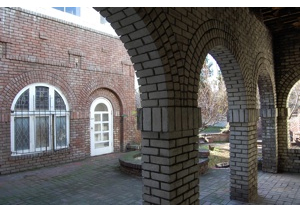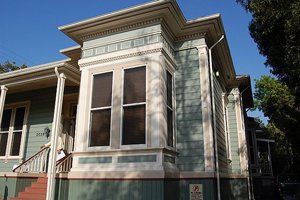IF ONLY WALLS COULD SPEAK!
- Details
- Category: Architecture
- Published on Thursday, 23 June 2016 15:40
- Written by MITZI MARCH-MOGUL
 People often think of history as an impersonal collection of facts and dates, a dusty inventory of data without relevance to modern life. But the past can get quite personal when looked at as the stories of people like us and how their actions and feelings influenced, and sometimes left a lasting impact on their communities and society.In the West Adams District, these stories are right under our noses, if we only take the time to look. History is not a dry recitation of facts; it’s the story of people and what they did and how and why they did it. But if you don’t have a name, how do you find the story? Houses (and other types of structures) provide the names through building and municipal records, architectural archives, historical publications, and other documents. The older homes are a gateway to a rich and entertaining narrative—drama and comedy, tragedy and romance, beautiful and terrible. In a way, because we live in these homes, we become a continuation of the story.
People often think of history as an impersonal collection of facts and dates, a dusty inventory of data without relevance to modern life. But the past can get quite personal when looked at as the stories of people like us and how their actions and feelings influenced, and sometimes left a lasting impact on their communities and society.In the West Adams District, these stories are right under our noses, if we only take the time to look. History is not a dry recitation of facts; it’s the story of people and what they did and how and why they did it. But if you don’t have a name, how do you find the story? Houses (and other types of structures) provide the names through building and municipal records, architectural archives, historical publications, and other documents. The older homes are a gateway to a rich and entertaining narrative—drama and comedy, tragedy and romance, beautiful and terrible. In a way, because we live in these homes, we become a continuation of the story.As a Historic Preservation Consultant, a lot of my time is spent researching people who lived long ago. Some stories are more interesting than others, but as a whole, it is fascinating to learn what life was like fifty or one hundred years ago; in some ways it has changed very little, and in other ways how improved it has become!
Many people who made lasting contributions are still known today as they live on in the names of streets where they had interests. Crenshaw, Pico, Dalton, Rimpau, Degnan, Leimert and Hoover (to name a few) all had an impact on how Los Angeles developed and they lived right here in West Adams.
Others lived in obscurity until research uncovered their story. A home in Harvard Heights became the center of a zoning issue which required researching the history of the property. It turned out that the house had been designed by a master architect for a downtown businessman and later became the Mormon Mission. Beginning in 1929, for two decades the house served as the central location for LDS Church activities and some of the most important leaders of the church lived there or conducted business and religious meetings there. Few people realize that the Mormons made significant contributions to the development of Los Angeles and Southern California, including founding San Bernardino. We are so fortunate that the house was still there, largely unchanged, so that we could uncover the important story that it represented. It is now a Los Angeles Historic-Cultural Monument.
Another home in West Adams represents 135 years of Los Angeles history. Built circa 1876, it is one of the oldest identified still-standing Victorian-era wood-framed homes, a rarity indeed. Although it had been in the same family since the 1930s, it wasn’t until a few years ago that its full history emerged. In 1875, Thomas Bruen Brown had just earned his law degree in Washington, D.C., arriving in Los Angeles, where he became District Attorney. He purchased the property, planted his acres in oranges, and hired the most prominent architect of the day to build a fine Italianate-style home for his soon-to-be bride. He
 married Eleanor Thornton Patton, daughter of Susan Glassell Patton, widow of Confederate Colonel George Patton, and whose brother was Andrew Glassell, founder of Glassell Park. Eleanor would later be the aunt of General George S. Patton, Jr. Her sister would later marry Hancock Banning. These “first families of Los Angeles” would remain entwined for many years, shaping the future of Los Angeles. By the time the Gorsline family purchased the house in 1934 the neighborhood had changed significantly. Gone were the orange groves and vineyards, but the house remained, again largely unchanged, waiting to reveal its glorious past and its connection to these interesting and important people.
married Eleanor Thornton Patton, daughter of Susan Glassell Patton, widow of Confederate Colonel George Patton, and whose brother was Andrew Glassell, founder of Glassell Park. Eleanor would later be the aunt of General George S. Patton, Jr. Her sister would later marry Hancock Banning. These “first families of Los Angeles” would remain entwined for many years, shaping the future of Los Angeles. By the time the Gorsline family purchased the house in 1934 the neighborhood had changed significantly. Gone were the orange groves and vineyards, but the house remained, again largely unchanged, waiting to reveal its glorious past and its connection to these interesting and important people.Do you live in an older home? Do you know when it was built or who built it? Have you ever thought about what it was like when it was new? What the neighborhood like? If you had lived there in those early years, what would daily life have been like? Men would have been wearing shirts with high stiff collars and hat—straw for the summer, wool felt during the winter. Women would be wearing many layers of undergarments, long dresses and high button shoes. Relief came in the 1920’s when clothing (at least for women) became loose and short. What story lies buried by time, waiting for an opportunity to pull back the curtain of time? If you purchased your house fairly recently, you might be eligible for the Mills Act Property Tax Rebate Program, but to qualify you must be either a Historic Cultural Monument (HCM) or a Contributor in a Historic Preservation Overlay Zone. Becoming an HCM starts with a story—yours.
There are so many homes with fascinating, glamorous, startling stories, too many to tell in this space. And there are thousands more still waiting to be discovered. I sometimes joke that I am catching up on my newspaper reading—I’m only about 100 years behind!
Categories
-
Architecture
IF ONLY WALLS COULD SPEAK!
 People often think of history as an impersonal collection of facts and dates, a dusty inventory...
People often think of history as an impersonal collection of facts and dates, a dusty inventory...
-
Our History
BRIDGET "BIDDY' MASON: Founder of the First African American Methodist Church FAME
 Originally posted on blackdoctor.orgWhen we talk about Black History, we hear a lot of names over...
Originally posted on blackdoctor.orgWhen we talk about Black History, we hear a lot of names over...
-
In Memory Of
Barbara Morrison Celebrated Jazz Singer Dies at 72
 Barbara Morrison, a legendary singer in the Los Angeles jazz and blues music community, has died....
Barbara Morrison, a legendary singer in the Los Angeles jazz and blues music community, has died....
Today10
Yesterday10
Week47
Month247
All964861
Kubik-Rubik Joomla! Extensions
Yesterday10
Week47
Month247
All964861
Currently are 20 guests and no members online
Kubik-Rubik Joomla! Extensions




